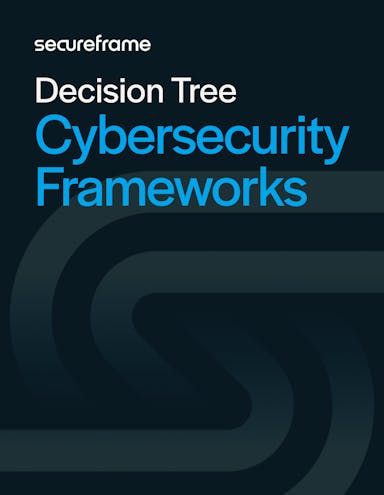
The Critical Role of Cybersecurity Audits and How to Conduct One
Emily Bonnie
Senior Content Marketing Manager
Rob Gutierrez
Senior Cybersecurity and Compliance Manager, CISA, CCSK, CMMC RP
In the first quarter of 2024, the average number of cyberattacks per organization per week was 1,308, — a 28% increase from the last quarter of 2023. The total cost of cybercrime is predicted to reach $9.5 trillion in 2024 and exceed $10.5 trillion in 2025.
To stay secure, businesses must stay one step ahead of potential threats. And as the saying goes, the best offense is a good defense.
Cybersecurity audits are one way organizations can take a proactive approach to fortify their security posture and stay ahead of cyber threats. In this article, we explore the steps involved in conducting an effective internal cybersecurity audit and highlight the benefits of this critical practice.
What are cybersecurity audits and why are they important?
A cybersecurity audit is a comprehensive evaluation of an organization's information systems, policies, and procedures to ensure they align with established security standards and best practices. The main goals of a cybersecurity audit are to:
- Identify potential vulnerabilities and/or risks in systems and processes that could be exploited by cyber threats.
- Verify compliance with relevant laws, industry regulations, and industry standards. Compliance is crucial to avoid legal penalties and to maintain trust with stakeholders.
- Gain actionable insights into improving the organization's security posture, including implementing stronger security controls, updating policies, and improving incident detection and response.
Regular security audits allow your organization to be proactive about strengthening its data security practices and staying aware of any new or escalating threats. They can also reveal valuable insights about your organization's operations, such as the effectiveness of your security awareness training, the presence of redundant or outdated software, and whether new technologies or processes have introduced vulnerabilities.
Cybersecurity audits vs. Cybersecurity assessments
Cybersecurity audits and cybersecurity assessments are similar and can easily be confused. While both aim to enhance an organization’s security posture, they serve distinct purposes.
A cybersecurity audit looks at the processes, policies, and controls an organization has in place to determine whether they are comprehensive and identify any gaps. Cybersecurity audits are typically performed against specific framework or regulatory requirements, such as HIPAA or GDPR.
A cybersecurity assessment is a high-level analysis of the organization’s overall GRC maturity that examines the operating effectiveness of security controls.
While both cybersecurity audits and assessments aim to enhance an organization’s security, they differ in their focus, scope, and outcomes. Choosing between them depends on whether the primary goal is compliance (audit) or improving IT security (assessment).

Cybersecurity frameworks decision tree
Use this series of questions to help select the best cybersecurity framework(s) based on your industry, data, and needs.
Benefits of conducting a cybersecurity audit
Regular cybersecurity audits are crucial for identifying vulnerabilities, ensuring compliance, improving operational efficiency, and maintaining a robust security posture. They provide actionable insights that drive continuous improvement and help build a culture of security within the organization, ultimately protecting the organization’s assets, reputation, and bottom line.
Let’s review some of the most important benefits of cybersecurity audits.
Stronger security posture
The cybersecurity landscape is constantly evolving. Regular audits help organizations stay ahead of emerging threats. By regularly assessing and updating security measures, organizations can adapt to changes in the threat landscape and maintain robust defenses. Audits also hold employees and departments accountable for their role in maintaining the organization’s security posture, encouraging adherence to security policies and best practices.
Regular audits help identify security weaknesses and vulnerabilities that could be exploited by cyber threats. By regularly assessing and addressing risks, organizations can proactively manage potential threats and reduce the likelihood of security incidents.
Audits can also reveal gaps in policies, enabling organizations to improve their security control posture and implementation.
Regular audits ensure that data protection measures are effective and up-to-date, safeguarding sensitive information from unauthorized access and breaches. Audits help ensure compliance with data protection regulations, protecting the organization from legal repercussions related to data breaches.
Continuous compliance
Regular audits ensure that the organization remains compliant with relevant laws, regulations, and industry standards, avoiding potential legal penalties and non-compliance fines.
Demonstrating ongoing compliance through regular audits can also enhance the confidence of customers, partners, and other stakeholders in the organization’s commitment to security.
Improved operational efficiency
Audits can identify inefficient or outdated security processes, providing opportunities for streamlining and improving operational efficiency.
By pinpointing areas that require more attention and resources, audits help optimize the allocation of security resources and investments.
Informed strategic decision-making
The findings from regular audits provide actionable insights and recommendations, enabling informed decision-making regarding security improvements and investments. Audit results can inform strategic planning and the development of long-term security strategies.
Better third-party risk management
Regular audits can assess the security practices of third-party vendors, ensuring that they meet the organization’s security requirements and do not introduce additional risks.
Similarly, demonstrating that the organization conducts regular audits can build trust with clients, partners, and stakeholders, showing a commitment to maintaining high security standards.
Proactive reputation management
Preventing security breaches through regular audits helps protect the organization’s reputation and maintain customer trust. A strong security posture demonstrated by regular audits can serve as a competitive advantage, attracting security-conscious customers and partners.
By identifying and mitigating security risks, audits help prevent costly security breaches and incidents. Regular audits and a strong security posture can lead to better terms and lower premiums for cybersecurity insurance.
When and how to perform an internal cybersecurity audit
Cybersecurity audits should be conducted at least annually. Depending on your organization's risk profile, industry regulations, and changes in the IT environment, more frequent audits may be necessary. For example, high-risk industries like healthcare can benefit from quarterly audits.
When it comes time to conduct your internal cybersecurity audit, you can use the steps listed below as a starting point for a comprehensive assessment and tailor them to your organization’s needs.
Step 1: Define goals and scope
The first thing you’ll need to do is decide what your goals are for the cybersecurity audit.
You might be preparing to get certified for a specific cybersecurity framework or need to complete an internal audit to maintain compliance. Perhaps you’re proactively monitoring your security posture over time, or looking for ways to improve your internal processes and eliminate redundancies. Whatever the reason, establishing clear goals will help focus your audit.
The next task is to define the scope of your audit by listing all of your information assets, including hardware, software, information databases, and any sensitive internal or legal documents.
Then you need to decide who is doing the audit. When selecting an internal person to conduct the audit it is important to ensure they have the proper qualifications and materials, as well as a clear list of criteria and standards they are conducting the internal audit against.
Finally, review your list and decide what needs to be included in your audit and what doesn’t. Your stated goals will help you narrow down the list and remove everything that doesn’t specifically fall within the scope of your cybersecurity audit.
Step 2: Identify threats
Next, go down the list of in-scope assets you identified in step 1 and define the security risks that could impact each. Consider threats that could affect data confidentiality, integrity, and availability for each asset. For example, weak access controls like shared credentials could compromise sensitive information by allowing unauthorized access.
Now that you’ve identified risks, you can make a realistic plan for treating them. First, consider the likelihood each risk will occur and each risk’s potential impact on your organization. You can use these rankings to prioritize risks that are most significant to your business.
Step 3: Conduct the cybersecurity audit
For each threat on your prioritized list, you’ll need to determine a corresponding security measure. For the weak access controls example, you could implement multi-factor authentication or single-sign-on to prevent credential sharing.
What is your organization already doing to either eliminate cybersecurity threats or minimize their likelihood and impact? Are there any gaps or deficiencies you can identify? If you have established cybersecurity policies, are they being followed in practice?
Here are key areas an internal cybersecurity audit should focus on:
Security policies and procedures
Access controls
Network security
Data protection and privacy
Endpoint security
Application security
Incident response
Security awareness training
Physical security
Compliance
Third-party and cyber risk maangement
Audit trails and logging

Internal Security Audit Checklist
Use this comprehensive checklist to guide your next internal security audit.
Step 4: Create a remediation plan
Whenever you identify a gap in your security processes or policies, document it and create a plan to address it. Assign a primary owner for each gap, along with a remediation timeline, to ensure accountability and action.
For example, your cybersecurity audit reveals that some employees are using outdated software without the latest security patches. Your remediation plan involves implementing a device management tool like Kandji or Fleetsmith to enable automatic software updates on all devices. Assign the IT director as the primary owner with a three-month deadline to select and implement the tool.
Step 5: Communicate results
Share the results of the cybersecurity audit with stakeholders, including company management and IT or security compliance teams. Provide an overview of the audit goals, evaluated assets and controls, new or unresolved risks, and your remediation plan.
You can also use the results as the basis for your next audit, allowing you to track improvements over time and keep a close eye on areas that still need attention. By maintaining ongoing awareness of various threats and educating your teams on protective measures, you can foster a culture of enhanced security throughout your company.
The benefits of continuous monitoring over point-in-time cybersecurity audits
Traditionally, organizations have relied on periodic cybersecurity audits to evaluate their security posture and ensure compliance with industry standards. While these audits are valuable, they have significant limitations in addressing the dynamic nature of modern cyber threats.
In many ways, continuous monitoring offers a more effective and proactive approach to safeguarding an organization’s digital assets. Let’s take a closer look at how companies can benefit from implementing a continuous monitoring tool rather than relying on point-in-time cybersecurity audits.
Static snapshots vs real-time insights
Cybersecurity audits offer a snapshot of the security posture at a specific point in time. This approach does not account for the rapidly changing threat landscape or the constant evolution of an organization’s IT environment. By the time an audit is completed, the findings may already be outdated. Because audits are typically conducted on an annual or semi-annual basis, vulnerabilities can go undetected for months — leaving the organization exposed to potential attacks.
Continuous monitoring provides ongoing, real-time visibility into an organization’s security posture. This enables security teams to detect and respond to threats as they emerge, rather than waiting for the next audit cycle to identify and address issues. It also allows organizations to be more reactive and adaptive to change. Organizations are constantly adding new tools, personnel, and devices. Continuous monitoring ensures that any new vulnerabilities that are introduced as companies scale are quickly identified and addressed.
Reactive vs proactive approach
Audits often identify issues after they have already posed a risk. This reactive approach means that security teams are always playing catch-up, addressing vulnerabilities and compliance issues only after they have been identified in the audit process.
By continuously monitoring network traffic, system configurations, and user behaviors, organizations can identify and mitigate potential threats before they can cause harm. This proactive approach helps in preventing security incidents rather than just reacting to them.
Continuous monitoring also ensures that an organization remains compliant with compliance requirements at all times. Automated tools can flag deviations from compliance standards as they occur, allowing for immediate corrective actions. This proactive approach to compliance management is particularly valuable in industries with stringent framework and regulatory requirements.
While cybersecurity audits play a role in maintaining security and compliance, audits alone are no longer sufficient. Continuous monitoring is a necessity for a more effective, proactive, and dynamic approach to cybersecurity.
Recommended reading

7 Benefits of Continuous Monitoring & How Automation Can Maximize Impact
How to automate internal cybersecurity audits
As important as cybersecurity audits are to fortify your business, they are incredibly time and resource-intensive. Our leading security and compliance automation platform can eliminate a majority of the manual effort involved with conducting audits, reducing the potential for human error and giving you real-time insights into your cybersecurity program and risk profile.
- Continuous control and compliance monitoring: Get complete visibility with actionable insights on critical security and privacy compliance issues.
- Vulnerability management and AI-powered remediation guidance: Leverage auto-generated fixes for infrastructure as code so you can easily copy, paste, and deploy fixes to your cloud environment.
- Automated risk assessments: Using a risk description, Comply AI for Risk automatically produces an inherent risk score, treatment plan, and residual risk score so you can improve their risk awareness and response.
- Third-party risk management: Track vendor compliance status and potential third-party risks to make sure your sensitive data is safe across your ecosystem.
- Personnel management and security awareness training: Get the tools you need to inform and train your personnel and ensure they follow regulatory requirements.
With thousands of happy customers, our platform simplifies the process of monitoring and strengthening your company’s information security and compliance posture. Learn more about our leading platform by requesting a demo.
Use trust to accelerate growth
FAQs
How do I prepare for a cybersecurity audit?
Preparing for a cybersecurity audit typically involves the following steps:
- Clearly define audit scope, including systems, networks, policies, and procedures.
- Gather documentation, including security policies, network diagrams, incident response plans, and previous audit reports.
- Review policies and procedures to ensure they are up-to-date and compliant with relevant standards.
- Review access controls to verify that sensitive data is adequately protected.
- Ensure the incident response plan is current and that all employees are familiar with their roles in the event of a breach.
- Conduct employee training to ensure staff are aware of the audit and understand their roles in maintaining cybersecurity.
- Prepare to provide information and answer questions during interviews with auditors.
What is the difference between an IT audit and a cybersecurity audit?
An IT audit evaluates the effectiveness and efficiency of IT controls, including operational and financial controls. It is broadly focused on all IT systems and processes, including hardware, software, networks, data management, and IT governance.
A cybersecurity audit focuses on the security- and compliance-related aspects of IT. It focuses on the effectiveness of cybersecurity measures in identifying vulnerabilities, including network security, data protection, threat management, incident response, and user access controls.
How long does a cybersecurity audit take?
The duration of a cybersecurity audit can vary widely depending on the size and complexity of the organization, the scope of the audit, and the level of preparation. Generally, a cybersecurity audit can take anywhere from a few weeks to several months. For small to medium-sized businesses, it might take 2-4 weeks, while larger enterprises could require 1-3 months or more.
What does a cybersecurity audit check for?
A cybersecurity audit typically checks for:
- Network security, including firewalls and intrusion detection systems
- Data protection, including encryption, backup, and data recovery processes
- Access controls, including user access policies, authentication mechanisms, and authorization protocols
- Incident response plans and procedures
- Vulnerability management, including how vulnerabilities are identified, assessed, and mitigated
- Compliance with relevant cybersecurity standards, regulations, and best practices
- Physical security and access to IT infrastructure
- Security policy and process documentation
- Employee training and awareness programs
- Third-party risk management practices
How often should cybersecurity audits be done?
Cybersecurity audits should be conducted at least annually to ensure continuous compliance and security. However, depending on the organization’s risk profile, industry regulations, and changes in the IT environment, more frequent audits may be necessary. High-risk industries or organizations undergoing significant changes (such as mergers, acquisitions, or major IT infrastructure updates) might benefit from quarterly or semi-annual audits.

Emily Bonnie
Senior Content Marketing Manager
Emily Bonnie is a seasoned digital marketing strategist with over ten years of experience creating content that attracts, engages, and converts for leading SaaS companies. At Secureframe, she helps demystify complex governance, risk, and compliance (GRC) topics, turning technical frameworks and regulations into accessible, actionable guidance. Her work aims to empower organizations of all sizes to strengthen their security posture, streamline compliance, and build lasting trust with customers.

Rob Gutierrez
Senior Cybersecurity and Compliance Manager, CISA, CCSK, CMMC RP
Rob Gutierrez is an information security leader with nearly a decade of experience in GRC, IT audit, cybersecurity, FedRAMP, cloud, and supply chain assessments. As a former auditor and security consultant, Rob performed and managed CMMC, FedRAMP, FISMA, and other security and regulatory audits. At Secureframe, he’s helped hundreds of customers achieve compliance with federal and commercial frameworks, including NIST 800-171, NIST 800-53, FedRAMP, CMMC, SOC 2, and ISO 27001.